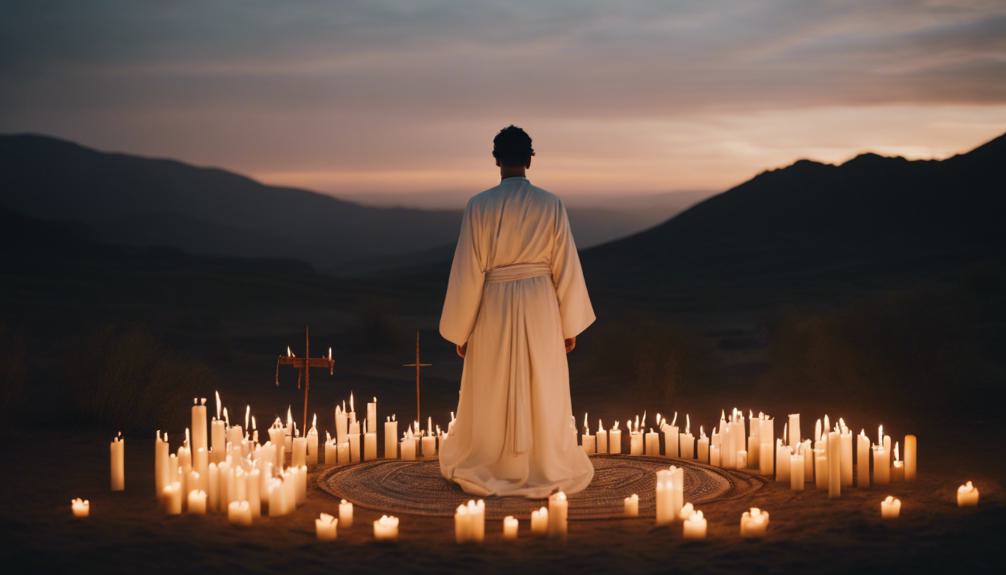What Is White Robe: Symbolism & Tradition Explored
Imagine a grand ceremony where a figure in a flowing white robe commands attention and respect, embodying tradition and spirituality in a single garment. This attire, known as a white robe, holds a rich history and cultural significance that transcends borders and time.
From ancient rituals to modern practices, the symbolism behind the white robe continues to captivate and intrigue individuals worldwide. But what intricate details and hidden meanings lie beneath the surface of this iconic garment?
Join us on a journey to unravel the depths of the white robe’s essence and explore its enduring allure in various contexts.
Key Takeaways
- White robes symbolize purity, spirituality, and authority throughout history.
- They vary in meaning across cultures, representing different virtues and values.
- White robes are used in religious ceremonies to emphasize purity and spirituality.
- Modern interpretations blend tradition with contemporary aesthetics, symbolizing growth and elegance.
Origins of White Robe Tradition
The origins of the white robe tradition can be traced back to ancient civilizations, where the symbolic significance of purity and spirituality was first associated with this attire. White robes, often called White Robes, have held ceremonial significance in various cultures and traditions throughout history. The color white has long been symbolic of purity and cleanliness, making it a natural choice for attire associated with rituals, religious practices, and special events.
In ancient times, white robes were worn by individuals of authority or those tasked with important ceremonial roles. The white color symbolized their readiness for service and their elevated status within the community. Both men and women could don white robes, signifying their participation in significant events or their alignment with spiritual practices.
The tradition of donning white robes has evolved over centuries, adapting to different cultural contexts and belief systems. Despite these variations, the underlying symbolism of purity and spirituality has remained constant. White-robed figures have been depicted in literature, art, and religious ceremonies, showcasing the enduring relevance and significance of this attire in various societal practices. The White Robe tradition continues to be a powerful symbol of ceremonial importance and spiritual devotion in many contemporary settings.
Symbolism Behind the White Robe

Symbolizing purity and spirituality across diverse cultures, what deeper meanings are embedded within the white robe attire? White robes hold significant symbolism beyond their physical appearance. Here are some key points to ponder:
- Purity: White robes are often associated with purity due to their clean and pristine appearance. The color white has long been linked with innocence and cleanliness, reflecting a sense of spiritual purity in various traditions.
- Spirituality: The wearing of white robes signifies a spiritual connection or enlightenment. In many religious practices, donning a white robe is a symbolic representation of one’s devotion to a higher power or a spiritual journey.
- Formality: White robes are frequently reserved for formal or ceremonial occasions. The formality of the attire adds a sense of reverence and respect to the event or ritual in which they’re worn.
- Authority: Throughout history, white-robed attire has been a symbol of authority. Leaders, priests, and figures of importance often wear white robes to signify their elevated status and influence within a community.
The symbolism behind white robes extends beyond mere clothing, carrying deeper meanings that resonate with individuals across different cultures and contexts.
Practices and Rituals Associated

Practices and rituals involving white robes are deeply ingrained in various religious and ceremonial traditions, symbolizing purity and spiritual significance. White robes play a significant role in rituals such as baptism, confirmation, and ordination across different faith traditions. These robes are worn by clergy, initiates, or participants to indicate their readiness for divine service and symbolize a new beginning or spiritual transformation.
| Practices and Rituals Associated with White Robes | Description |
|---|---|
| Baptism | White robes symbolize purification and |
| new life as individuals are initiated | |
| into the religious community. | |
| Confirmation | Participants often wear white robes to |
| signify their commitment to their faith. | |
| Ordination | Clergy members wear white robes during |
| the ordination ceremony to show readiness | |
| for their new role in the church. | |
| Easter Celebrations | White robes are worn to represent new |
| life and spiritual rebirth during this | |
| important Christian holiday. |
The tradition of wearing white robes during significant religious events has been upheld for centuries, emphasizing the enduring symbolic importance of purity and spirituality in various cultural contexts.
Modern Interpretations of White Robe

In contemporary contexts, white robes have evolved to symbolize purity, spirituality, and elegance, reflecting modern interpretations that extend beyond traditional religious connotations. White robes are now more versatile and are utilized in various settings beyond religious practices. Here are some key points defining modern interpretations of white robes:
- Fashion Adaptations: Designers have incorporated white robes into modern trends, blending traditional symbolism with contemporary aesthetics to create stylish and elegant attire.
- Theatrical Significance: White-robed attire is frequently used in theatrical performances and themed events, enhancing the visual appeal and adding a sense of mystique and sophistication to the overall presentation.
- Cultural Relevance: The global presence of white robes highlights their enduring significance across cultures, serving as a unifying symbol that bridges tradition with modern interpretations.
- Symbolism Evolution: While still representing purity, white robes now also embody spirituality and elegance in a broader sense, appealing to individuals seeking a deeper connection to these qualities through their attire.
These aspects illustrate how white robes have transcended their traditional religious roles to become multifaceted symbols that resonate with contemporary values and aesthetics.
Benefits of Embracing White Robe

Embracing white robes can signify purity, spirituality, and formality across various cultural contexts, embodying historical connotations of authority in significant events or rituals. The benefits of donning white robes extend beyond mere symbolism; they also serve as a visual representation of victory, joy, peace, and perfection. This attire, historically associated with authority figures, continues to hold relevance in contemporary society.
White robes are versatile garments suitable for both men and women, offering a unifying aesthetic that transcends gender boundaries. The cultural significance of white robes has endured through time, with modern interpretations showcasing its adaptability in religious practices, fashion trends, theatrical performances, and themed events. By embracing the white robe, individuals can tap into a rich tapestry of tradition and symbolism that enhances their presence in various social settings.
Furthermore, those who wear white robes often occupy special societal roles, contributing to the preservation of cultural identity on a global scale. The enduring appeal of white-robed attire lies in its ability to evoke a sense of reverence, elegance, and authority, making it a valuable asset in both personal expression and communal rituals. Embracing the white robe not only connects individuals to a rich historical legacy but also empowers them to embody qualities of purity and spirituality in their everyday lives.
Frequently Asked Questions
What Does White Robed Mean?
When you see someone in white robes, it usually symbolizes purity or spirituality. Such attire often signifies innocence or holiness in literature. Characters in white robes often play important roles in stories and religious ceremonies worldwide.
What Does White Robes Mean in Revelation?
In Revelation, white robes symbolize purity and victory over sin. They represent righteousness and redemption for the chosen. Wearing white robes signifies heavenly glory and the cleansing power of Christ’s sacrifice, emphasizing themes of spiritual purity.
What Does White Robe Mean Catholic?
In Catholicism, the white robe signifies purity and holiness. This garment is worn by priests, deacons, and altar servers. Bishops and cardinals wear a white cassock called a soutane, while the pope dons a papal soutane as a symbol of his office.
What Is the White Robe in the Church?
In the church, the white robe, known as an alb, symbolizes purity, innocence, and holiness. It is worn by priests and clergy members as a representation of their role as representatives of Christ.
Conclusion
To sum up, the white robe tradition has deep roots in various cultures, symbolizing purity, spirituality, and formality. Its symbolism and significance in practices and rituals continue to be embraced worldwide, with modern interpretations adapting to contemporary contexts.
Embracing the white robe can bring a sense of connection to tradition, spiritual awareness, and cultural heritage, making it a timeless garment with enduring benefits for individuals and communities alike.
